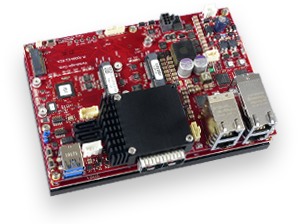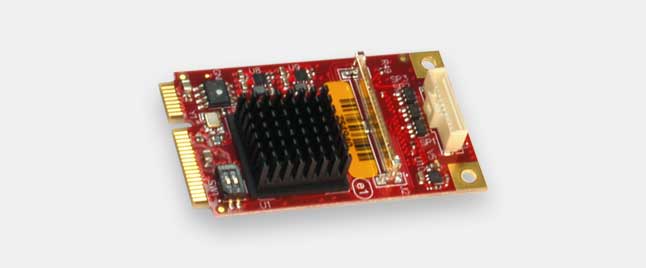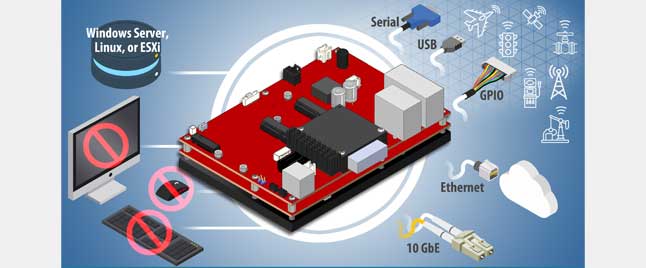NEWS, EVENTS & BLOG
BLOG

Is a Headless Computer Right for Your Application: Edge Servers
Press Office, VersaLogic Corporation, 04/28/21
Part Two: Edge Servers
Last week, VersaLogic posted the first blog in this two-part series “Is a Headless Computer Right for Your Application?” That blog covered the need for headless SBCs in the generalized case when power is limited. This blog will cover the much different use case of edge micro-servers. For those that missed last week’s blog, let’s summarize what is meant by “headless” with regard to industrial SBCs.
Embedded/industrial single board computers (SBCs) come in a variety of sizes, shapes, performance levels, and functionality. In most cases, they include connectivity to human machine interface (HMI) devices such as keyboards, mice, and video displays (KVM).
However, in some use cases, HMI functions are not required and in others, it might even be detrimental. The term “headless” is used to describe an SBC that has no HMI connectivity. Usually, there is no display connector. USB connections usually remain as they can be used for connection to other I/O devices.
Why Headless for an Edge Server?
Whether it’s a rack server running in a data center at a comfortable temperature, or a rugged micro-server such as Grizzly running in an extreme environment in an edge application, neither need an HMI. There may be times during system development that an HMI is needed, but not when it’s deployed.
For servers that are deployed, there are better management options. Typically this is via the Intelligent Platform Management Interface (IPMI).
Intelligent Platform Management Interface
The Intelligent Platform Management Interface (IPMI) was developed by a group of companies including Intel, Dell, Hewlett Packard, and NEC. The specification is now at version 2.0.
IPMI provides the following capabilities for servers:
- Server health monitoring
- Making BIOS changes
- Recovery and restart
- State logging
- Server inventory listing
Most importantly all of this can be achieved remotely via an Ethernet connection using an Out-of-Band (OOB) connection. OOB capability enables IPMI functions to be accessed remotely without the OS running. Security for these connections is enhanced by the use of Remote Management Control Protocol, RMCP+, which includes encryption capabilities.
 The Grizzly edge micro-server may be remotely managed using IPMI
The Grizzly edge micro-server may be remotely managed using IPMI
Installation of an Operating System or Hypervisor
The installation and usage of an operating system (OS) on headless systems varies with the support provided by the OS vendor for that particular configuration. For example, server versions of Linux operating systems tend to not install a graphical desktop by default for this reason. In the case of Linux (Ubuntu Server 18.04) and VMWare ESXi, it is possible to perform the install in “headless” mode. More information on this type of OS installation is available in VersaLogic’s Headless Operating System Installation Whitepaper.
If HMI is Needed
In some situations, local HMI capability is required, for example, during system development or debug. Headless SBCs will usually have USB ports, so connection of a keyboard and mouse is not a problem.
However, a display is still needed. For the Grizzly, which has mini PCIe sockets, the answer is to use a video card such as the MPEe-V5.
 MPEe-V5 mini PCIe video expansion card
MPEe-V5 mini PCIe video expansion card
Does Being Headless Save Enough Power?
As previously stated, a major benefit of headless SBCs is the reduction of power consumption. This is an advantage in some applications, but it is typically a small percentage of the total power draw in a server-based system. Omitting the video circuity leaves space on the circuit board for additional functions, which is usually advantageous in server products.
For computers in edge applications, power may be a challenge. One solution is to choose the server carefully. The Grizzly is designed around Intel®’s Denverton processors that are available with up to 16 cores. These processors consume less power than the Intel® Xeon® processor family, with full server functionality. Please see a prior blog, Atomic Servers: High Core Count Intel® Atom™ Server Solutions for details.
In Closing
Headless SBCs are most often used in applications where power is very constrained. In the case of a server, an HMI is not a requirement and management is performed over IPMI 2.0. In the limited situations when an HMI is required, such as during system development, an add-on video card is an easy solution.
Need additional Information?
Want to know more about VersaLogic’s range of embedded products? Let’s start a conversation.

